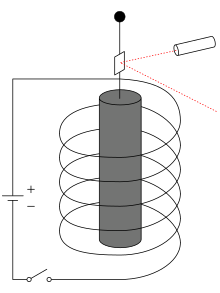Einstein de Haas effect
The Einstein-de-Haas effect shows the connection between ferromagnetism and the angular momentum of electrons . It is a macroscopic proof of the spin angular momentum of the electrons. The effect was predicted in 1908 by OW Richardson , albeit in relation to the orbital angular momentum , and thus also proven in 1915 by Albert Einstein together with Wander Johannes de Haas .
experiment

A thin, magnetizable rod (e.g. made of iron, nickel) hangs vertically on a torsion thread in a perpendicular magnetic coil . Since the magnetic field is parallel to the rod and the entire arrangement is rotationally symmetrical, the magnetic field cannot exert any torque on the rod. Nevertheless, it begins to rotate around the hanging direction when the magnetic field is switched on or the polarity reversed.
interpretation
The entire angular momentum of the rod is made up of two parts: one part corresponds to the externally visible rotational movement, the other part is the sum of the permanent angular momentum of the electrons. These are usually disordered, so their sum is zero. The macroscopic magnetization results from their parallel position . If the rod is at rest and not magnetized before the magnetic field is switched on, the total angular momentum is zero, because both components are zero. Since nothing can change in the total angular momentum zero by switching on, both angular momentum components must always be oppositely equal. Therefore, the visible rotation shows that the magnetization of the rod is linked to a certain angular momentum, which can be measured by observing the visible rotation. The measured ratio of the rod's magnetic moment to this angular momentum (the gyromagnetic ratio ) agrees with the gyromagnetic ratio observed for individual electrons.
The reverse of this effect is the Barnett effect .
Historical
The observed effect is only small, so that a resonance oscillation is used to make it more measurable. For this purpose, the rod is built up as a rotary pendulum with a certain resonance frequency and an alternating magnetic field of variable frequency is applied to the coil. When tuning the frequency, the amplitude of the torsional vibration shows a clear resonance curve . However, the quantitative evaluation with regard to the gyromagnetic ratio is not easy. For example, the ferromagnetic hysteresis in the rod creates the complication that the magnetization and thus also the angular momentum do not change linearly with the external field. The results obtained are therefore subject to a relatively high degree of uncertainty, which Einstein and de Haas estimated at 10%. However, your measured value was wrong by a factor of two, as other authors found out over the next few years by repeating the experiments with improved structures.
Einstein and de Haas had found the result that corresponded to the theoretical explanation of ferromagnetism at the time. It was then wrongly assumed that the electrons move on circular paths and thus cause the Ampère molecular currents that generate the magnetic field. The magnetic moment, which is actually twice as large, cannot be explained by the circling of electrons, but only by their own angular momentum or spin , for which there is no mechanical explanation. The electron spin was not introduced until 1925 and, together with its anomalous magnetic moment, was theoretically established in 1928.
See also
literature
- D. Meschede: Gerthsen Physik . 23rd edition. Springer, Berlin, Heidelberg 2006, ISBN 978-3-540-25421-8 , pp. 395 .
- Demtröder: Experimentalphysik, 4th edition, Vol. 3, p. 168
- H. Haken and HC Wolf: Atomic and Quantum Physics. Introduction to the experimental and theoretical basics , Springer, Heidelberg 2000.
- Peter Galison : Theoretical predisposition in experimental physics: Einstein and the gyromagnetic experiments 1915-1925, Historical Studies in the Physical Sciences, Volume 12, 1982, Issue 2
Web links
- Einstein de Haas effect. (pdf; 1.5 MB) Description of an experiment. Project laboratory TU-Berlin, January 17, 2001, pp. 1–70 , accessed on November 26, 2017 .
- LP: The Einstein-de-Haas-Effect , Georg-August-Universität Göttingen
Individual evidence
- ^ OW Richardson, A mechanical effect accompanying magnetization , Physical Review (Series I), Vol. 26 , Issue 3, pp. 248-253 (1908). [1]
- ↑ a b Albert Einstein, WJ de Haas: Experimental proof of Ampere's molecular currents . In: Negotiations of the German Physical Society . tape 17 , 1915, pp. 152–170 ( full text in Internet Archive BookReader - from S 152- .. ).
- ↑ a b A. Einstein, WJ de Haas: Experimental proof of the existence of Ampère's molecular currents . In: Koninklijke Akademie van Wetenschappen te Amsterdam (KNAW), Proceedings . tape 18 , no. I , 1915, p. 696–711 (English, 'Digital Library' of the Dutch History of Science Web Center 2001 [PDF; 654 kB ]).
- ^ Emil Beck: For the experimental proof of Amperes molecular currents In: Annalen der Physik Vol. 60, 1919, pp. 109-148